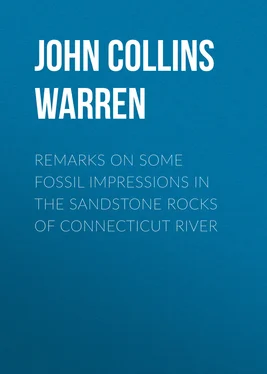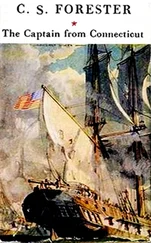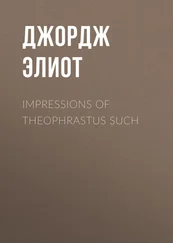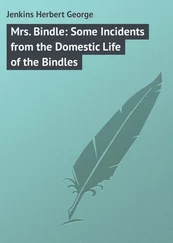John Collins Warren - Remarks on some fossil impressions in the sandstone rocks of Connecticut River
Здесь есть возможность читать онлайн «John Collins Warren - Remarks on some fossil impressions in the sandstone rocks of Connecticut River» — ознакомительный отрывок электронной книги совершенно бесплатно, а после прочтения отрывка купить полную версию. В некоторых случаях можно слушать аудио, скачать через торрент в формате fb2 и присутствует краткое содержание. Жанр: foreign_antique, Биология, foreign_edu, на английском языке. Описание произведения, (предисловие) а так же отзывы посетителей доступны на портале библиотеки ЛибКат.
- Название:Remarks on some fossil impressions in the sandstone rocks of Connecticut River
- Автор:
- Жанр:
- Год:неизвестен
- ISBN:нет данных
- Рейтинг книги:3 / 5. Голосов: 1
-
Избранное:Добавить в избранное
- Отзывы:
-
Ваша оценка:
- 60
- 1
- 2
- 3
- 4
- 5
Remarks on some fossil impressions in the sandstone rocks of Connecticut River: краткое содержание, описание и аннотация
Предлагаем к чтению аннотацию, описание, краткое содержание или предисловие (зависит от того, что написал сам автор книги «Remarks on some fossil impressions in the sandstone rocks of Connecticut River»). Если вы не нашли необходимую информацию о книге — напишите в комментариях, мы постараемся отыскать её.
Remarks on some fossil impressions in the sandstone rocks of Connecticut River — читать онлайн ознакомительный отрывок
Ниже представлен текст книги, разбитый по страницам. Система сохранения места последней прочитанной страницы, позволяет с удобством читать онлайн бесплатно книгу «Remarks on some fossil impressions in the sandstone rocks of Connecticut River», без необходимости каждый раз заново искать на чём Вы остановились. Поставьте закладку, и сможете в любой момент перейти на страницу, на которой закончили чтение.
Интервал:
Закладка:
John Collins Warren
Remarks on some fossil impressions in the sandstone rocks of Connecticut River
Plate: Image of sandstone slab with fossil track and footprint impressions.
The principal part of these remarks were made at the meetings of the Boston Society of Natural History. A portion of them also have been printed in the Proceedings of the Society.
The object of this publication is to afford to those who are not members of the Society an opportunity of obtaining some knowledge of Fossil Impressions, which they might not be able to obtain elsewhere so conveniently.
Some account of the Epyornis seems to be very properly connected with Ornithichnites.
The first of these papers was written in October, 1853; the others in the earlier part of the present year.
THE EPYORNIS;OR,
GREAT BIRD OF MADAGASCAR, AND ITS EGGS
In the course of the year 1851, an account was circulated of the discovery of an immense egg, or eggs, in the Island of Madagascar. The size of the eggs spoken of was so disproportionate to that of any previously known, that most persons received the account with incredulity; and, I must confess, I was one of this number. Being in Paris soon after hearing of this report, I made inquiry on the subject, and was surprised to learn, that the great egg was actually existing in the Museum of Natural History in Paris. In a few days I had an opportunity of seeing a cast of it in the hands of the artist, M. Strahl, of whom I solicited one. He informed me that it could not be obtained at that moment; but that, if my request were made known to the Administration of the Museum, he had no doubt they would accede to it. I accordingly did apply, and also presented them with the cast of a perfect head of Mastodon Giganteus; and they very liberally granted my request.
The distinguished naturalist, Professor Geoffroy St. Hilaire, the second of that honorable name, has made a statement to the Academy of Sciences, which, though only initiatory, contains many facts of a very interesting nature, some of which I have had an opportunity of verifying; and to him we are indebted for a greater part of the others.
The eggs sent to me are, in number, two; one of which was purchased by M. Abadie, captain of a French vessel, from the natives. Another was soon afterwards found, equal in size. A third egg was discovered in an alluvial stratum near a stream of water, together with other valuable relics of the animal which had probably produced them; but, unfortunately, it was broken during transportation. Of the two eggs, one is of an ovoid form, having much the shape of a hen's egg; and the other is an ellipsoid.
The ovoid egg is of enormous size, even when compared with the largest egg we are acquainted with. Its long diameter exceeds thirteen inches of our English measure, its short diameter eight, and its long circumference thirty-three inches. Its capacity is thought to be equal to eighteen liquid pints, or to be six times greater than that of the largest egg known to us (the ostrich), although but twice its length. It is said to be equal to a hundred and forty-eight hen eggs. The ellipsoid egg has its longest diameter somewhat less than that of the ovoid; its short diameter nearly equals that of the other egg, being more than eight inches. The third egg, although broken, has been very useful to science, by displaying the thickness of the shell, which is about one-tenth of an inch.
The bones, of which I have received the casts, are three in number, and of great interest. One of them is a characteristic fragment of the upper part of a fibula; the other two, still more interesting, as enabling us to determine the class and genus of the animal to which they belong, exhibit the extremities of the right and left tarso-metatarsal bones. The former is somewhat broken; the latter is nearly perfect, and exhibits the triple division of the inferior extremity of the bone into the three trochleæ or pulley-shaped processes of the struthious birds. It might be mistaken for a bone of the great Dinornis, but is distinguished from this by the flatness of the portion above the trochleæ. Still less is it one of the bones of the ostrich, its three pulleys being separated from each other by distinct intervals; whereas the pulleys of the ostrich have only one such separation, constituting two distinct eminences.
M. Geoffroy St. Hilaire considered himself justified, from these and other facts, in deciding this bone to belong to a bird of a new genus, to which he gives the name of Epyornis, from αἰπύς , high , tall , and ὄρνις , bird ; and, as probably it is a specimen of the largest animal of the family, he affixes the specific name of maximus .
The size of this bird, inferred from that of its egg, would be vastly superior to that of the ostrich. But if we notice the comparative size of the trochleated extremity of the tarso-metatarsal bone, we shall see that its height would be greatly exaggerated by adopting such a basis for its establishment; in fact, it would not probably exceed a height double that of the ostrich. And, though it must have been superior to that of the Dinornis maximus of Prof. Owen, it might perhaps excel it only by the difference of two or three feet. A bird of twelve or thirteen feet in height would, however, if we stood in its presence, appear enormous, and must have greatly astonished and terrified the natives of Madagascar. Whether it now exists is uncertain, as it may possibly have a habitation in the wild recesses of the island, which have never yet been visited by any European traveller.
The credit of most of the observations and discoveries relating to this remarkable bird is attributable to French naturalists; 1 1 The following are the names of French travellers, who have been supposed to have seen the eggs of the Epyornis in the Island of Madagascar: M. Sganzin, in 1831; M. Goudot, in 1833; M. Dumarele, in 1848; and M. Abadie, in 1850.
and it seems to be a duty devolving on English and American navigators to complete the history thus happily begun, and to tell us whether the Epyornis still exists in the mountain-forests of Madagascar, or at least present us with its extraordinary relics.
FOSSIL IMPRESSIONS.—I
Ichnology, a newly created branch of science, takes its name from the Greek word ἴχνος , a track or footstep , and the tracks themselves have been denominated Ichnites, or, when they refer to birds only, Ornithichnites, from ὄρνις , a bird . And this last term has by custom been generally applied to ancient impressions, though not correctly.
Geology has revealed to us not only the remains of animals and vegetables, but the impressions made by them during their lives, and even the impressions of unorganized bodies. The first notice of these appearances was, as often happens, regarded with indifference or scepticism; but their number and variety enlightened the public mind, and opened a new source of information and improvement.
The first remarkable observation made on fossil footsteps was that of the Rev. Dr. Duncan, of Scotland, in 1828. He noticed, in a new red sandstone quarry in Dumfriesshire, impressions of the feet of small animals of the tortoise kind, having four feet, and five toes on each foot. They were seen in various layers through a thickness of forty feet or more.
Sandstone, in which these impressions are principally discovered, is a rock composed chiefly of siliceous and micaceous particles cemented together by calcareous or argillaceous paste, containing salt, and colored with various shades of the oxide of iron, particularly the red, gray, brown. It has been remarked by Prof. H. D. Rogers, that the perfection of the surface containing fossil footmarks is often attributable to a micaceous deposit. The layers of sandstone have been formed by deposits from sea-water, dried in succession; such layers are also seen in the roofing slate. These deposits on the shores of the ocean, having in a soft condition received the impressions of the feet of birds, other animals, vegetables, and also of rain-drops, under favorable circumstances dried, hardened, and formed a rock of greater or less solidity. Our colleague, Dr. Gould, has exhibited to us a specimen of dried clay from the shores of the Bay of Fundy, containing beautiful impressions, recently made, of the footsteps of birds. The particles brought by the waves, and deposited in the manner described, were derived from the destruction of other rocks previously existing, particularly granite and flint, or silex, the shining atoms of which compose no small part of the sandstone rock.
Читать дальшеИнтервал:
Закладка:
Похожие книги на «Remarks on some fossil impressions in the sandstone rocks of Connecticut River»
Представляем Вашему вниманию похожие книги на «Remarks on some fossil impressions in the sandstone rocks of Connecticut River» списком для выбора. Мы отобрали схожую по названию и смыслу литературу в надежде предоставить читателям больше вариантов отыскать новые, интересные, ещё непрочитанные произведения.
Обсуждение, отзывы о книге «Remarks on some fossil impressions in the sandstone rocks of Connecticut River» и просто собственные мнения читателей. Оставьте ваши комментарии, напишите, что Вы думаете о произведении, его смысле или главных героях. Укажите что конкретно понравилось, а что нет, и почему Вы так считаете.












